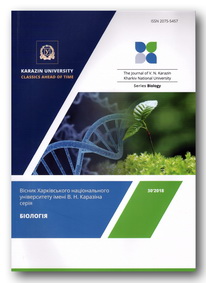Morphofunctional rearrangements of adrenal cortex of adult rats at the experimental microelementosis
Abstract
Xenobiotics, including salts of heavy metals, determine the development of pathology of individual organs and systems of the body. Adrenal hormones occupy a key place in the regulation and maintenance of the organism basic functions. The study of morphological, biochemical and immunohistochemical changes in the adrenal cortex of pubescent male rats at exposure to the complex of heavy metal salts remains an actual aspect of modern morphology. The experiment involved 24 white adult male rats weighing 250–300 g, aged 7–8 months. The animals of the experimental group consumed ordinary drinking water saturated with a combination of heavy metal salts (Zn, Cu, Fe, Mg, Cr) for 60 days. Histological, biochemical (determination of the content of hormones COR – cortisol, DHS – dehydroepiandrosterone sulfate) and immunohistochemical (determination of the expression of proliferation marker Ki-67) methods were used. Long-term consumption of the combination of heavy metals salts by mature rats leads to thickening of the stromal component of the gland, the rupture of capillaries and the violation of rheological properties of blood. Chromatin condensation, its marginal location, and initial stages of necrobiotic changes have been found in the spongiocyte nuclear apparatus. For endocrinocytes of the zona glomerulosa and zona reticularis of the gland, a slight increase in proliferative activity has been revealed, while cells of the zona fasciculata were non-reactive. These results correlate with the results of biochemical research, according to which hormones of the zona reticularis – DHS were actively involved in the formation of adaptive reactions in the body of experimental animals at the 60-day period of administration of the complex of heavy metals salts. The results of complex studies indicate a weakening of the secretory activity of cells of the zona fasciculata, which adversely affects the development of compensatory-adaptive processes in the body and the course of the general adaptation syndrome in response to the action of the damaging agent.
Downloads
References
Grabovsky S.S. (2014). Morphometric characterization of adrenal glands and kidneys under conditions of pre-slaughter stress during the use of biologically active substances. Studia Biologica, 8(2), 43–56. (In Ukrainian)
Hryntsova N.B. (2017). Morphological rearrangements of the structural components of the intermediate lobe of the pituitary gland of female adult rats under the influence of heavy metal salts. European Conference on Innovations in Technical and Natural Sciences: 15th International scientific conference. Vienna, Austria, pp. 3–8. (In Ukrainian)
Gubar I.V., Kozlov K.P., Levchenko I.L. (2007). The influence of low doses of lead, mercury and manganese on reographic indices of white rats of different age. Modern Problems of Toxicology, 4, 8–10. (In Ukrainian)
Dmitrukha N.M. (2009). To the problem of immunotoxicity lead and cadmium (literature review)). Modern Problems of Toxicology, 1, 4–9. (In Ukrainian)
Lugovskоy S.P. (2005). Morphological and functional pattern of cerebrum of rats under chronic exposure with small doses of lead. Modern Problems of Toxicology, 3, 23–28. (In Ukrainian)
Lutsik S.O., Yashchenko A.M. (2018). Immunohistochemical study of adrenal glands in rats progeny grown in the conditions of experimental hypo and hypertension of the maternal body. World of Medicine and Biology, 4(66), 175–180. https://doi.org/10.26724/2079-8334-2018-4-66-175-180 (In Ukrainian)
Rogozina O.V., Ozerova N.Y., Kashirina N.K. (2009). Morphology of adenohypophysis and adrenal gland under the influence of lead intoxication and its correction. World of Medicine and Biology, 3, 136–140. (In Ukrainian)
Rozhkov I.M., Hordienko V.M. (2005). Some aspects of histophysiological changes of adrenal corticocytes at chronic nitrate intoxication and its correction by swimming. Sports Medicine, 1, 75–78. (In Ukrainian)
Skotarenko T.A. (2015). Modern views on the morphofunctional state of the adrenal glands in normal, acute inflammation and the possibility of their influence on fetoplacental tissues. Actual Problems of Modern Medicine, 15(2), 237–241. (In Ukrainian)
Trakhtenberg I. (2008). The book about poisons and poisoning. Ternopil: Ternopil State Medical University, "Ukrmedkniga", pp. 122–123. (In Ukrainian)
Harvey P.W., Everett D.J., Springall C.J. (2007). Adrenal toxicology; a strategy for assessment of functional toxicity to the adrenal cortex and steroidogenesis. J. Appl. Toxicol., 27, 103–115. https://doi.org/10.1002/jat.1221
Hinson J.P., Raven P.W. (2006). Effects of endocrine-disrupting chemicals on adrenal function. Best Pract. Res. Clin. Endocrinol. Metab., 20, 111–120. https://doi.org/10.1016/j.beem.2005.09.006
Koller L.D. (1980). Immunotoxicology of heavy metals. Int. J. Immunopharmacol., 2, 269–279. https://doi.org/10.1016/0192-0561(80)90027-2
Ng T.B., Liu W.K. (1990). Toxic effect of heavy metals on cells isolated from the rat adrenal and testis. In Vitro Cellular & Development Biology, 26(1), 24–28. https://doi.org/10.1007/BF02624150
Rana S.V.S. (2014). Perspectives in endocrine toxicity of heavy metal. Biological Trace Element Research, 160(1), 1–14. https://doi.org/10.1007/s12011-014-0023-7
Rastogi R.B., Singhal R.L. (1975). Effect of chronic cadmium treatment on rat adrenal catecholamines. Endocrine Research Communications, 2(1), 87–94. https://doi.org/10.1080/07435807509053840
Romanyuk A.M., Hryntsova N.B., Karpenko L.I. et al. (2019). The long-term effect of the complex of heavy metal salts on the morphofunctional changes in the structural components of the intermediate lobe of the mature rat's pituitary gland-the female. Problems of Endocrine Pathology, 2, 98–103. https://doi.org/10.21856/j-PEP.2019.2.14
Romaniuk A., Sikora V., Lyndin M. et al. (2017). The features of morphological changes in the urinary bladder under combined effect of heavy metal salts. Interventional Medicine and Applied Science, 9(2), 105–111. https://doi.org/10.1556/1646.9.2017.2.09
Authors retain copyright of their work and grant the journal the right of its first publication under the terms of the Creative Commons Attribution License 4.0 International (CC BY 4.0), that allows others to share the work with an acknowledgement of the work's authorship.




